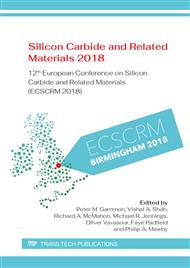p.105
p.109
p.114
p.119
p.123
p.127
p.131
p.136
p.141
New SiC Epitaxial Growth Process with up to 100% BPD to TED Defect Conversion on 150mm Hot-Wall CVD Reactor
Abstract:
The future challenges for SiC device technology are cost reduction and increased reliability. A key point to achieve that is the increase of yield during epitaxial layer growth through the reduction of structural defects (such as basal plane dislocations and triangle defects), an increased thickness and doping uniformity, and a high growth rate. Despite significant advancements in SiC epitaxial growth technology, it still constitutes a big challenge to find the optimum working point at which all those requirements are fulfilled. By implementing a new epitaxial layer growth process, we are able to grow basal plane dislocation free epitaxial layers, while the density of other structural defects remains low. Additionally, intra-wafer thickness and doping uniformities of the epitaxial layers are further improved.
Info:
Periodical:
Pages:
123-126
Citation:
Online since:
July 2019
Authors:
Price:
Сopyright:
© 2019 Trans Tech Publications Ltd. All Rights Reserved
Share:
Citation:


